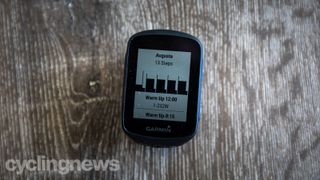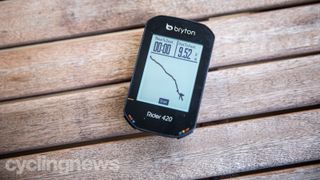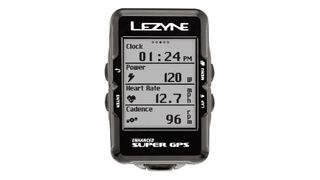It really is amazing what technology we can fit in the palm of our hand – mobile smartphones are one thing while the best cycling computers are another. GPS cycling computers can range from affordable to ridiculous, with capabilities including GPS tracking, Bluetooth, maps, speed, distance, time, and even Wi-Fi connection. Higher-end computers wirelessly connect to sensors such as options from the best power meters and can track your power output, cadence, left/right balance, and more. And that’s not all – many computers can connect to third-party apps such as Strava, Zwift, and Komoot.
While some the best cycling computers such as the Garmin Edge 1030 Plus, run as high as £500, there are cheaper options on the market with many of the same capabilities. In this buyer’s guide, we’ll help you sift through the marketing jargon, and pick out a few of our favorites from the best budget cycling computers segment.
Read on for our pick of the best budget cycling computers available today, or if you’re unsure of which model is best for you, check out our advice on how to choose the best budget cycling computer.
Best budget cycling computers
The Garmin Edge 130 Plus is about as simple as it gets, with a few buttons to help navigate its screens, and ANT+ and Bluetooth capabilities. Experienced riders and those who value performance will love the Edge 130, which can pair with heart rate monitors, cadence sensors, and power meters.
However, it is a bit pricier than many of the other options on this list, so if you’re not interested in power or heart rate data, the Edge 130 is a bit too much. You can even load Strava live segments onto the Edge 130. The lack of touchscreen is both a pro and a con, depending on which you prefer. Garmin’s higher-end computers use touchscreens, but ultimately it is up to you to decide.
Read about how the Garmin Edge 130 Plus performed in our full review.
One of the newer companies on the market is Bryton and while the company isn’t one of the most popular brands, you can get a lot more bang for your buck with its products. The Rider 420 is a fantastic cycling computer that barely costs more than £100.
Unfortunately, Bryton computers aren’t the easiest to figure out, as the user interface tends to have a bit of a learning curve. But once you’re in, the features are almost unlimited – complete with 77 functions and a claimed 35-hour battery life, the Bryton 420 support ANT+ and Bluetooth sensors, and auto-syncs to third-party training software. You can even export workouts directly from TrainingPeaks through the device, and set up your screens and data field through the companion smartphone app. Sounds a lot like the Wahoo Elemnt series which costs more than twice as much.
For more details on how the Bryton Rider 420 cycling computer performed during testing, read our full review.
Here’s the entire list of this computer’s functions: speed, distance, time, and clock. That’s it – but don’t let that dissuade you. The Cateye Quick Wireless Cycle Computer is a sleek and slim product that takes out all the fluff of modern data recording. Without power, heart, cadence, and all that nonsense, the Cateye simply tells you how far you rode and how long it took you. Simple.
It’s a refreshing outlook but, of course, it’s not for everyone. The unit comes with a handlebar mount that puts it right out front, and it is as light and aero as any other cycling computer. We’re not really sure why the battery life is described in years, but we’re not complaining it lasts that long. To serious riders and anyone wanting navigation or connectivity: the Cateye won’t be an option but for many others – like commuters and beginner cyclists – this affordable budget cycling computer could be the perfect fit.
While it isn’t the best-looking cycling computer on the market, it is certainly one of the most valuable. For a fraction of the price of many of its competitors, the Lezyne Mini GPS includes navigation capabilities, its own smartphone app, as well as power, cadence, and heart rate data-reading capabilities.
The unit’s small screen may be hard to read, but most riders don’t find it problematic since the display shows just two data screens at a time. For serious or performance-focused cyclists on a budget, the £95 Lezyne Mini GPS is a great option.
Unlike the Cateye we’ve listed above, the Lezyne Super GPS has almost all the features you could ask for – and at a fraction of the price of similarly capable rivals such as the Garmin Edge 530. In addition to power meter connectivity, phone notifications, offline maps, rerouting, and GPS navigation, the Super GPS even includes the ability to complete structured workouts, a feature that many associate with high-end Garmin or Wahoo models.
The Lezyne Super GPS isn’t the most beautiful cycling computer, and its screen doesn’t even have colour; but that only adds value because those costs are taken off the price tag. Its display is functional and its design helps improve battery life past the 24-hour mark. The Super GPS can even connect to the Lezyne Ally companion app for easier navigation and computer customisation.
When Stages Cycling first released the Stages Dash, it was seen as an affordable and lightweight cycling computer designed to centralise the data-monitoring experience – the Dash L10 follows this ethos.
Fully integrated with Stages Link training software, the Dash L10 can put you through structured interval workouts, and even provide you with performance analysis on the back end. Few other cycling computers have this kind of capability, which really sets the Stages Dash L10 apart. However, you’ll need a Stages Link subscription in order to reach the unit’s full capabilities.
The big sacrifice is the lack of navigation – no GPS, no maps, and no breadcrumbs. The GPS does, however, track distance and speed, but that’s about it. In summary, the Stages Dash L10 goes against the trend that many cycling computer manufacturers have edged towards: navigation. Gravel riding, adventuring, and bike-packing are skyrocketing in popularity, and people want high-tech, colourful, updated maps that they can use to navigate anywhere in the world. The Stages Dash L10 doesn’t do that – instead, this unit is for the performance-focused rider who wants to improve their interval training and get as much data as they can from their head unit on a budget.
Pioneer has completed a big step up with the Pioneer SGX-CA600. The old SGX-500 head unit was a headache but the latest computer is a huge improvement in everything from its usability to the improved touchscreen.
While the unit’s touchscreen isn’t perfect, you can easily pair it with its companion app and set everything up through your smartphone. The touchscreen’s colour display is one of the best out of any unit on this list and it even comes with OpenStreet base maps preloaded into the unit, including navigation and turn-by-turn directions.
It’s true that the Pioneer SGX-CA600 is on the expensive side for a “budget cycling computer,” but that’s because it comes with unmatched features and in-depth pedaling metrics when paired with a Pioneer power meter. Serious cyclists and riders focused on their pedaling technique and efficiency will find everything they need and more on the SGX-CA600, making it one of the most versatile computers on our list.
How to choose the best budget cycling computer for you
Cost and value
Chances are, if you’re reading through a list of the best budget cycling computers, then you’re operating on a pretty tight budget. It’s no secret that cycling is expensive, and when you see cycling computers that cost £500, you begin to wonder what all the fuss is about.
If you’re a commuter who’s looking for new roads to explore, then you don’t need a high-end cycling computer capable of analysing your pedalling metrics and left/right balance. You need a computer with good GPS capabilities and an easy-to-use navigation system that works even when it’s dark and wet outside.
When it comes to value, there are a number of cycling computers on this list that skip the famous name (i.e. Garmin or Wahoo). Companies such as Bryton might not be the most popular or easy to use, but once you get familiar with the interface, the Bryton Rider 420 has nearly all the capabilities of higher-end models. So when you’re shopping on a budget, take a closer look at the options, not just the popular models.
Where you ride: display, battery life, and navigation
Perhaps the most important factor when choosing a cycling computer is where you ride. Consider the weather, the terrain, the amount of natural light you’ll get. Will a dim, black-and-white computer screen be readable? Or will you need to see the map on a brighter, colour screen?
The display is one of the biggest faults of many budget cycling computers, as they can be small, dim, and difficult to read. And the last thing you want to be doing while descending at 60km/h is squinting at your cycling computer, trying to see where the next turn is. A larger and brighter display is more common nowadays, even on budget models, but it’s always worth having a proper look at it before you commit to purchasing a new cycling computer.
Commuters won’t mind the short battery life of some budget cycling computers, but if you’re looking for any long adventures such as backpacking, you’ll need a computer with decent battery life. Some of the units on this list last only half a day, while others can make it well over 24 hours. Keep in mind that recording data, keeping your display backlit, and following navigation will drain your cycling computer’s battery much faster than normal.
Budget friendly cycling computers don’t always have the beautiful navigation maps of higher-end models which use a GPS chip and access to other satellite networks like GLONASS and Galileo. Many even have a base map pre-installed, which allows for seamless re-calculations, turn-by-turn directions, and, with some, you can even create routes directly on the device. Budget cycling computers, on the other hand, will often use ‘breadcrumb’ navigation, which is when the computer displays your route as a line that you follow – quite literally like following a trail of breadcrumbs.
Extras and features
These may not be the first thing on your mind when you’re shopping on a budget, but the plethora of features included in some of these budget cycling computers is what makes them truly special. WiFi and Bluetooth capability usually enable connection to third-party apps such as Strava and Komoot, which can be one of the most underrated features of a cycling computer. With these, you can connect to your phone, receive messages, re-route on the fly and go after Strava Live Segments. A few years ago, this level of capability was reserved for only the high-end cycling computers; but now, you can find these features in a number of budget options.
Which cycling computers work with Strava?
If uploading your rides to Strava is your motivation for getting a cycling computer, you’ll need to find one that can track your location as you ride, so look for something with GPS, Glonass or similar. Sadly a wheel-based speed sensor won’t cut it.
If you want to download routes from Strava onto your device, then look for smartphone app connectivity. The app will usually be able to integrate with Strava, allowing you to share data back and forth with ease.

















